Follow up of Management of Staff Occupational Health and Safety in Schools
Overview
This audit follows-up on recommendations from the 2013 audit, Management of Staff Occupational Health and Safety in Schools.
We found that both the Department of Education and Training (DET) and WorkSafe have acted to address the recommendations and underlying issues identified in the 2013 audit.
For DET, as the largest employer in Victoria, actions implemented should improve its oversight of schools’ OHS management and compliance, as well as its processes for returning injured employees to work earlier. As the regulator, management actions should allow WorkSafe to demonstrate the impact of its programs to improve workplace safety.
While both agencies are monitoring management’s progress in addressing recommendations, they both lack frameworks to support their audit committees to review the impact of actions. Agencies need to act promptly to address this in order to fully comply with their requirements under the Financial Management Act 1994. For DET, this gap has also limited its ability to clearly attribute improvements in claims and return to work performance to addressing the recommendations.
Follow up of Management of Staff Occupational Health and Safety in Schools: Message
Ordered to be published
VICTORIAN GOVERNMENT PRINTER August 2015 2015
PP No 65, Session 2014–15
President
Legislative Council
Parliament House
Melbourne
Speaker
Legislative Assembly
Parliament House
Melbourne
Dear Presiding Officers
Under the provisions of section 16AB of the Audit Act 1994, I transmit my report on the audit Follow up of Management of Staff Occupational Health and Safety in Schools.
In May 2013, my office tabled an audit on Management of Staff Occupational Health and Safety in Schools. The audit examined whether schools had managed health and safety risks to their staff, and whether the Department of Education and Training had provided schools with sufficient guidance, support and oversight. It also examined WorkSafe's involvement and impact on improving occupational health and safety performance in schools. The audit considered only school-based employees.
This follow-up audit examined the progress made in addressing the recommendations from our 2013 report. It found that both agencies have implemented actions to address the recommendations, however, audit committees are not reviewing the impact of these actions on performance issues.
Yours faithfully

John Doyle MBA FCPA
Auditor-General
5 August 2015
Auditor-General's comments
 John Doyle Auditor-General |
Audit team Chris Sheard—Engagement Leader Teri Lim—Team Leader Emily Arthur—Team member Engagement Quality Control Reviewer Kristopher Waring |
In February 2015 I released my first audit following up on audit recommendations from 2012–13. The inaugural report was the basis for further follow-up audits to verify the information agencies provided.
This report, focusing on the Department of Education and Training (DET) and WorkSafe, is the third in a series of follow-up reports that I intend to release this financial year. It provides Parliament and the community with information about improvements that DET and WorkSafe may have made in relation to my recommendations.
The 2013 audit Management of Staff Occupational Health and Safety in Schools identified weakness in systems and processes, resulting in our conclusion that DET did not hold schools to account for occupational health and safety (OHS) performance and had missed opportunities to learn from other sectors and improve schools' performance. We also found that WorkSafe could not demonstrate the impact of its workplace projects to address OHS issues in schools and had ceased regular engagement with DET. A total of nine recommendations were made with the aim of addressing the issues.
I commend both agencies for the actions they have taken to address the recommendations and underlying issues. Efforts have demonstrated a commitment to identifying more meaningful ways of implementing our recommendations.
In the context of DET being the largest employer in Victoria, it is positive that it is taking steps to improve its oversight of schools' OHS management and compliance. This is complemented by improved return to work processes assisting injured employees to return to work earlier.
As the regulator, one of WorkSafe's responsibilities is to improve workplace safety. Developing and implementing an agency-wide evaluation framework will allow it to demonstrate the effectiveness of its programs to address OHS risks in the workplace.
I wish to thank the staff at DET and WorkSafe for their constructive engagement throughout the audit process.

John Doyle MBA FCPA
Auditor-General
August 2015
Audit Summary
Background
Schools have a range of risks that need to be properly managed to make them safe and healthy workplaces, and to minimise the chance of staff being injured. In May 2013, we tabled an audit that examined whether schools had managed health and safety risks to their staff, and whether the Department of Education and Early Childhood Development—now the Department of Education and Training (DET)—had provided schools with sufficient guidance, support and oversight. We also examined WorkSafe's involvement and impact on improving occupational health and safety (OHS) performance in schools. This follow-up audit examines the progress made in addressing the recommendations.
Conclusions
Both DET and WorkSafe have demonstrated action to address all of the recommendations from VAGO's 2013 audit—Management of Staff Occupational Health and Safety in Schools—in some cases adopting an alternative approach to implementing them. VAGO considers that this is a positive indication of agencies identifying more meaningful ways of implementing our recommendations.
DET has addressed deficiencies in its claims management and return to work (RTW) processes, and is now performing better than non-government schools and the Victorian workers' compensation scheme in returning injured employees back to work. Implementing a new premium model in a timely manner that encourages schools to improve their RTW and claims management performance should support this.
DET is also taking steps to improve and monitor schools' compliance with the OHS management system.
This includes piloting initiatives to support high-priority schools, and enhancing current monitoring and reporting information systems.
WorkSafe has demonstrated its commitment to improve monitoring and evaluation at an organisational level. It is developing and implementing tools and processes to ensure periodic evaluation of OHS programs.
Both agencies have actively re-engaged each other through regular meetings at executive and management levels, representation on relevant agency committees and establishment of quarterly joint working group meetings. These have created opportunities for information and data sharing. However, both agencies lack frameworks to support their audit committees to review the impact of management actions in response to recommendations and assess whether they have addressed performance issues. This has limited DET's ability to clearly demonstrate that improvements in claims and RTW performance are attributable to its implementation of the recommendations.
Findings
Workers' compensation scheme trends
The 2013 audit found that non-government schools were consistently outperforming government schools in claims and RTW performance. However, DET had not done anything to understand or address this.
DET has subsequently identified and addressed deficiencies in its claims management and RTW processes. It is now performing better than non‑government schools and the Victorian workers' compensation scheme in returning injured employees back to work earlier. This is benchmarked annually using WorkSafe data. It also monitors whether it is improving against its own previous performance on a quarterly basis. DET intends to recommend options for a new premium model to government in August 2015.
Occupational health and safety compliance
In 2013, VAGO found that DET was not holding schools accountable or intervening to improve OHS compliance. Since then, it has rolled out OHS training for all employees and is currently piloting two programs. One pilot is aiming to improve targeted schools' OHS performance. The second pilot should allow DET to have greater oversight of all schools' compliance with OHS requirements.
DET is also currently developing an OHS Accountability Framework and a project to integrate its three separate incident reporting systems into one to more effectively manage OHS and workers' compensation.
WorkSafe
Our 2013 audit found that WorkSafe and DET had stopped regularly engaging in 2011. From December 2013, the two agencies have regularly worked together to share data and information on OHS and workers' compensation. This is expected to continue through quarterly joint working group meetings, as well as representation on each other's relevant committees.
In attempting to evaluate the impact of its workplace projects in schools, WorkSafe identified deficiencies in its monitoring and evaluation processes. It is currently developing an organisational approach to ensuring periodic evaluations occur.
Audit method and cost
The audit was conducted under section 15 of the Audit Act 1994, and was performed in accordance with the Australian Auditing and Assurance Standards. Pursuant to section 20(3) of the Audit Act 1994, unless otherwise indicated any persons named in this report are not the subject of adverse comment or opinion.
Total cost of the audit was $110 000.
Submissions and comments received
We have professionally engaged with the Department of Education and Training and WorkSafe throughout the course of the audit. In accordance with section 16(3) of the Audit Act 1994 we provided a copy of this report to those agencies and requested their submissions or comments.
We have considered those views in reaching our audit conclusions and have represented them to the extent relevant and warranted. Their full section 16(3) submissions and comments are included in Appendix A.
1 Management of staff occupational health and safety in schools
1.1 Introduction
Good occupational health and safety (OHS) practices encourage a safe and healthy work environment. Schools have a range of risks that need to be properly managed to make them safe and healthy workplaces, and to minimise the chance of staff being injured. Unsafe workplaces or work practices can result in significant financial costs to the employer and emotional and physical cost to the injured worker.
Where there is a breach in OHS practice and an injury occurs, workers' compensation legislation sets out the requirements for employers and injured workers around their rehabilitation and return to work (RTW). The Victorian workers' compensation scheme (the scheme) is a no-fault system. This means that a worker's entitlement to compensation is not a question of who was responsible for the injury, rather, it is determined by whether the injury was employment related according to the provisions of the Workplace Injury, Rehabilitation and Compensation Act 2013.
In May 2013, VAGO tabled an audit of Management of Staff Occupational Health and Safety in Schools. That audit examined whether schools were managing health and safety risks to their staff, and whether the Department of Education and Training (DET)—the former Department of Education and Early Childhood Development—had provided them with sufficient guidance, support and oversight. As WorkSafe is responsible for enforcing OHS regulations, the audit also examined its involvement and impact on improving OHS performance in schools.
The VAGO 2013 audit made nine recommendations aimed at:
- enhancing DET's understanding of its schools' OHS and workers' compensation performance to make improvements
- DET's management of schools' compliance with, and accountability for, OHS
- improving engagement between DET and WorkSafe.
This follow-up audit examined the progress made by DET and WorkSafe in implementing actions to address the recommendations made in the 2013 audit.
Figure 1A provides an overview of whether DET and WorkSafe have begun to address the recommendations from the audit.
Figure 1A
Status of recommendations
|
Recommendation |
DET |
WorkSafe |
|---|---|---|
|
Scheme trends |
||
|
Recommendation 1 |
||
|
Benchmarking claims performance |
✔ |
N/A |
|
Recommendation 2 |
||
|
Premiums |
✔ |
N/A |
|
Recommendation 3 |
||
|
Monitoring expenditure on additional costs |
✔ |
N/A |
|
Recommendation 4 |
||
|
RTW performance |
✔ |
N/A |
|
Occupational health and safety compliance |
||
|
Recommendations 5 and 6 |
||
|
School OHS performance |
✔ |
N/A |
|
WorkSafe |
||
|
Recommendation 7 |
||
|
Injury reduction |
N/A |
✔ |
|
Recommendations 8 and 9 |
||
|
Engaging with DET |
✔ |
✔ |
Source: Victorian Auditor-General's Office.
1.2 Workers' compensation scheme trends
1.2.1 Insurance claims and costs
In 2013, VAGO found that DET had not done any work to understand factors contributing to a difference in claims performance between government schools and non-government schools. The non-government school sector consistently outperformed government schools in all claims indicators. In addition, DET did not monitor or evaluate the additional costs it payed to injured school staff.
Figure 1B
Recommendations 1 and 3
|
The Department of Education and Early Childhood Development should:
|
Benchmarking claims performance
The 2013 VAGO audit considered the following claims indicators in assessing DET's performance:
- incidence of standard claims reported to WorkSafe
- the cost of claims—referred to as time loss—which is impacted by the number of standard claims reported, weekly compensation paid and the number of compensation days paid to an injured worker
- rate at which claimants RTW—indicators of this are:
- continuance rates, which is the percentage of claimants that are still receiving compensation benefits at a point in time—specifically 13, 26 and 52 weeks
- the RTW Index, which records the percentage of injured workers noted on the system as having not been working on the date six months after lodging their claim.
The 2013 audit found that government schools had consistently performed worse than non-government schools in all three claims indicators. Despite this, DET had not attempted to understand the reasons for these performance differences.
DET has addressed gaps in its benchmarking activities by:
- requesting comparative data annually from WorkSafe since 2013 for:
- RTW Index and continuance rates
- the number of standard claims reported
- the number of standard claims reported by cause of the injury
- discussing trends with WorkSafe at joint working group meetings
- monitoring DET performance against the WorkSafe data annually
- analysing the different workers' compensation schemes of other education and government sectors, discussed at its People and Culture Standing Committee meeting in May 2015.
In addition, DET has been monitoring its own performance on a quarterly basis since 2013 through:
- continuance rates
- top three causes of injury by days lost and paid claims costs
- total days lost, weekly workers' compensation benefits paid to injured workers, and number of claims.
Monitoring expenditure on additional costs
DET has acted to monitor expenditure on additional costs associated with injuries in schools. It has analysed the major additional costs associated with standard claims in schools and workers' compensation performance. This analysis identified the additional costs to DET not covered by its workers' compensation insurance policy, which include:
- loss of productivity due to time lost from work
- recruitment, training and staff replacement costs
- make-up pay
- penalties and legal costs associated with OHS and workers' compensation legislation breaches.
DET pays for these additional indirect costs on a one-off basis or as required through payroll expenses, Student Resource Package reimbursements and legal budgets.
DET advised that these additional costs are not incurred for every standard claim. At a more strategic level, the additional cost that would impact on DET's claims performance is loss of productivity due to time lost from work. The earlier an injured worker is successfully returned to work, the less time is lost from work. For this reason, DET monitors its additional cost through time loss.
DET's quarterly workforce report has been monitoring this since 2013 through:
- RTW Index
- continuance rates
- top three causes of injury by days lost and paid claim costs—this includes weekly compensation, medical and any other expenses
- claim totals for primary, secondary and special schools
- days lost—this reflects the number of days lost, with any part of a day constituting a day lost, for example, four hours lost equates to a day lost
- weekly compensation paid for primary, secondary and special schools—this is the benefits paid to an injured worker for time lost from work.
Figures 1C, 1D and 1E are summary tables from DET's quarterly workforce report to senior management. They demonstrate the department's monitoring and reporting of additional cost through time loss. They show the total cost to DET of the number of days lost for that pool of claims, at a particular point in time—March 2015. The department focuses on reducing the number of paid days lost, which indicates that it is returning injured employees back to work earlier.
These Figures demonstrate that the number of paid days lost decreased from 2012–13 to 2013–14 in DET primary, secondary and special schools. This resulted in a reduction in the total compensation paid in all settings, except DET secondary schools, where there was a slight increase of $26 000.
Figure 1C
Summary of primary schools' claim totals
|
Year |
Paid days lost (number) |
Total compensation paid ($million) |
Claims (number) |
|---|---|---|---|
|
2010–11 |
6 300 |
$1.146 |
281 |
|
2011–12 |
6 449 |
$1.55 |
282 |
|
2012–13 |
5 562 |
$1.162 |
244 |
|
2013–14 |
4 472 |
$1.053 |
260 |
Source: Victorian Auditor-General's Office from DET's quarterly workforce report.
Figure 1D
Summary of secondary schools' claim totals
|
Year |
Paid days lost (number) |
Total compensation paid ($million) |
Claims (number) |
|---|---|---|---|
|
2010–11 |
7 226 |
$1.299 |
371 |
|
2011–12 |
6 298 |
$1.286 |
291 |
|
2012–13 |
5 344 |
$1.071 |
317 |
|
2013–14 |
5 324 |
$1.097 |
309 |
Source: Victorian Auditor-General's Office from DET's quarterly workforce report.
Figure 1E
Summary of special schools' claim totals
|
Year |
Paid days lost (number) |
Total compensation paid ($million) |
Claims (number) |
|---|---|---|---|
|
2010–11 |
3 657 |
$0.569 |
123 |
|
2011–12 |
2 613 |
$0.369 |
125 |
|
2012–13 |
3 434 |
$0.541 |
157 |
|
2013–14 |
2 341 |
$0.357 |
168 |
Source: Victorian Auditor-General's Office from DET's quarterly workforce report.
In VAGO's 2015 Responses to 2012–13 Performance Audit Recommendations report, DET also reported that it would review absenteeism. This action was initiated in May 2015 and is due to be completed by December 2015.
1.2.2 Return to work performance
The VAGO 2013 audit identified that the gap between government schools' and non‑government schools' RTW rates had been increasing since 2011. However, DET had not investigated causes for the significant difference in RTW rates.
Figure 1F
Recommendation 4
|
The Department of Education and Early Childhood Development should further analyse its return to work process to identify any specific changes that may be required to be most effective in the government school environment. |
The 2013 audit noted that DET had engaged a consultant to review its claims management processes and support schools to proactively manage claims. DET subsequently employed the consultant in the newly created position of Manager of Workers' Compensation.
Since 2011, DET has been implementing actions in response to the findings and recommendations of a review by a specialist. In 2013, the specialist reviewed DET's workers' compensation performance again for the periods 2010–11 to 2012–13. Based on the 2011 and 2013 review findings and recommendations, DET has implemented the following:
- claims management initiatives:
- selected and trained a new occupational rehabilitation provider (ORP) panel
- requested a restructure of its WorkSafe agent to provide a more holistic approach to claims management
- established monthly tripartite claim review meetings between DET, ORP and its agent to provide greater oversight and consistency of claims management
- established quarterly claim reviews with the agent to monitor and improve claims and RTW performance
- early intervention initiatives:
- improved RTW processes to support early referral to ORP
- trained WorkSafe agent and ORP on 'host placement' and 'compassionate transfer' options if an injured employee cannot return to the injury location
- developed a series of emails to schools to encourage prompt RTW planning
- engaged an additional resource from 2013 for its workers' compensation advisory service to increase support to schools in carrying out their workers' compensation and RTW requirements
- developed resources and training to guide schools in managing claims and RTW processes.
Effective claims management and early intervention are key factors in returning injured workers to work earlier, thereby reducing lost time. DET data demonstrates the following improvements have occurred since implementation of its workers' compensation initiatives:
- 6.3 per cent reduction in lost time from 16 050 days paid in 2012–13 to 15 032 in 2013–14
- 11.8 per cent improvement in injured workers returning to work within 13 weeks from 52.1percent in 2012–13 to 63.9 per cent in 2013–14
- 41.8 per cent improvement in overall RTW performance—RTW of injured workers by 13, 26 or 52 weeks—from 2009–10 to 2013–14.
In addition, DET is undertaking a project to develop a single information technology system to manage all its incidents, which is currently managed in three separate systems. This should improve end-to-end management of OHS and workers' compensation.
WorkSafe data for the March 2015 quarter shows that DET has improved its performance with government schools performing better at returning people to work earlier than non-government schools and the scheme. This is highlighted in Figures 1G to 1J, which focus on the RTW Index and continuance rates at 13, 26 and 52 weeks.
Improved performance is evident from early 2013—before DET started to address recommendations from VAGO's 2013 audit.
Figure 1G shows that DET schools' RTW Index has improved significantly since quarter 3, 2013, and while there has been a slight decline in performance over the past financial year, DET is still performing better than the non-government school sector.
The extent to which the improvement is attributable to VAGO's recommendations is unclear. While DET's audit committee is required to assess the impact of actions stemming from recommendations, it has not done this. This is a missed opportunity to understand how effective DET's actions have been.
Figure 1G
Return to work Index
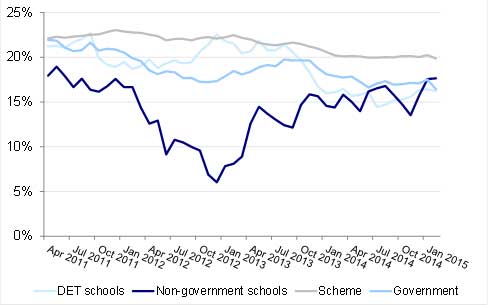
Source: Victorian Auditor-General's Office from WorkSafe March 2015 quarter data.
Figures 1H, 1I and 1J demonstrate DET schools' continuance rates at WorkSafe's identified key milestones in the life of a claim—13, 26 and 52 weeks. WorkSafe uses these milestones to present RTW performance. These have been improving since mid–2012, and government schools are now outperforming non-government schools:
- from quarter 1, 2014 for 13 and 26 week continuance rates
- from quarter 4, 2014 for 52 week continuance rates.
Figure 1H
13 week continuance rate
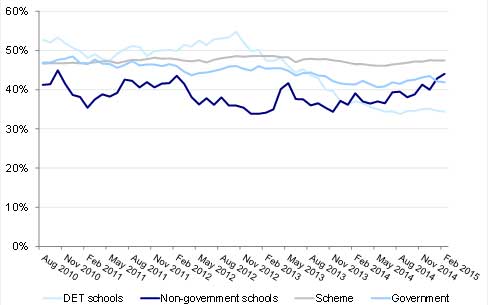
Source:Victorian Auditor-General's Office from WorkSafe March 2015 quarter data.
Figure 1I
26 week continuance rate
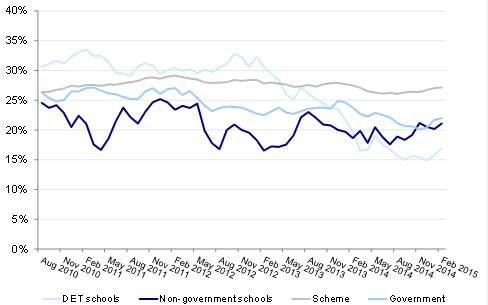
Source: Victorian Auditor-General's Office from WorkSafe March 2015 quarter data.
Figure 1J
52 week continuance rate
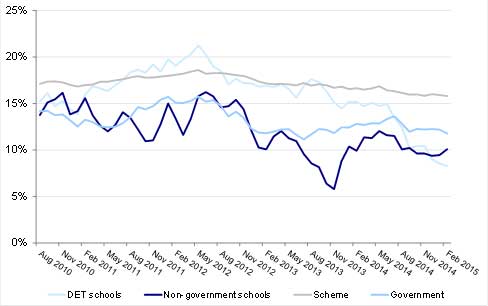
Source: Victorian Auditor-General's Office from WorkSafe March 2015 quarter data.
1.2.3 Premiums
The VAGO 2013 audit found that DET's model for allocating insurance premiums did not act as an incentive for schools to improve their OHS performance. This was because DET subsidises the premiums it levies to individual schools and applies a maximum ceiling of $10 000 per school. Collectively, schools were only contributing 3.4 per cent of the true premium cost in 2012–13.
Figure 1K
Recommendation 2
|
The Department of Education and Early Childhood Development should investigate models for WorkSafe premium distribution that provide enhanced incentives for schools to improve OHS performance. |
DET has addressed this by appointing consultants in May 2014 to investigate and develop an alternative model. DET received a final report in January 2015 providing several model options. The recommended model will encourage schools to improve their RTW and claims management performance by:
- benchmarking the performance of similar schools using measures that are currently collected in WorkSafe data
- providing quarterly feedback on performance.
Currently, schools' premium payments are not based on any benchmarking or feedback of performance.
DET intends to recommend options for a new premium model to government in August 2015. If the new model is effective in encouraging schools to improve their OHS performance, DET should share its learnings with other sectors.
1.3 Occupational health and safety compliance
The VAGO 2013 audit concluded that DET's OHS management system (OHSMS) was robust and assisted schools to meet their OHS requirements. However, compliance with the system was low. DET did not hold schools to account for poor OHS performance, despite policy requirements to intervene and target underperforming schools.
1.3.1 School occupational health and safety performance
In 2013, VAGO found that while schools were expected to independently manage OHS risks and hazards, school leaders had no performance indicators or incentives to encourage improved OHS performance in their schools. While schools were required to meet OHS legislative requirements, there were no accountability mechanisms to ensure compliance with these obligations.
In addition, DET's OHS audits showed low compliance with the OHSMS. While DET had a contracted OHS service provider to support schools in becoming OHS compliant, it did not monitor the extent to which this was occurring and schools were reluctant to accept the external support offered.
Figure 1L
Recommendations 5 and 6
|
The Department of Education and Early Childhood Development should:
|
DET has addressed these recommendations by providing OHS and workers' compensation training, piloting two OHSMS improvement programs and developing an OHS accountability framework.
Since December 2013, DET has rolled out 13 online e-learning modules covering a range of OHS and workers' compensation topics. Modules include OHS for Managers and Principals, and RTW Coordinator Roles and Responsibilities. Training is assigned to employees by their job role, and is to be completed by 30 June 2015.
DET is also piloting two programs to improve schools' compliance with the OHSMS. The first pilot program provides targeted support to identified high-priority schools, with escalation to deputy regional directors for non-engaged schools. The second pilot program provides schools with a tool to electronically record completion of OHSMS audit action items, and monitor their own levels of compliance and performance improvement. DET is then able to monitor schools' OHSMS compliance centrally.
To further reinforce its expectations, DET is developing an OHS accountability framework. It is currently identifying ways to integrate OHS into school performance criteria, aiming to implement this by the end of 2015.
1.4 WorkSafe
The VAGO 2013 audit concluded that WorkSafe was unable to show the impact of specific workplace projects targeting OHS in schools in 2008 as it had not evaluated these projects. WorkSafe had reprioritised efforts towards industries and hazards it had determined as higher risk, which resulted in fewer inspection projects targeted specifically at schools. WorkSafe was also no longer providing DET with regular reports on OHS performance.
Figure 1M
Recommendations 7, 8 and 9
|
WorkSafe should:
The Department of Education and Early Childhood Development and WorkSafe should:
|
1.4.1 Injury reduction
The VAGO 2013 audit found that WorkSafe had not comprehensively evaluated its projects targeting OHS in schools and was unable to demonstrate their effectiveness, or identify gaps or deficiencies in its processes.
In line with our recommendation, WorkSafe started to determine the impact of these workplace projects. However, it was unable to complete these due to lack of documentation, organisational restructure and key staff departure. To institutionalise the evaluation of programs and projects, WorkSafe developed a whole-of-organisation research strategy that provides ongoing funding for evaluation.
In VAGO's 2015 Responses to 2012–13 Performance Audit Recommendations report, WorkSafe reported that it would ensure periodic evaluation of health and safety programs. To achieve this, WorkSafe has allocated 30 per cent of its total 2014–15 research budget to evaluation work. This funding will allow the Institute for Safety, Compensation and Recovery Research to review the efficiency and effectiveness of WorkSafe's largest programs and projects. The WorkSafe corporate plan for 2014–15 provided for three evaluations to be started in 2014–15 on OHS programs and projects. WorkSafe has advised that two evaluations have started.
These actions demonstrate that WorkSafe has identified the need for a more strategic approach to addressing the audit recommendation and is taking action to implement this.
1.4.2 Engaging with the Department of Education and Training
The VAGO 2013 audit found that WorkSafe had not directly engaged with DET since October 2011, even though DET is the largest employer in Victoria. The audit also found that there were opportunities for WorkSafe and DET to work together to improve OHS performance in schools.
WorkSafe and DET have addressed these findings by re-engaging with each other. For example, there have been regular meetings at senior executive and management levels and both agencies have been proactive in working together to identify opportunities for data sharing. As a result, WorkSafe is regularly sharing data with DET on school OHS performance, compliance, claims trends, workplace visits, RTW performance, as well as other data that DET requests. Staff from each agency are also members of the other's working groups and committees. For example, WorkSafe is represented on DET's OHS Consultative Committee, and DET is represented on WorkSafe's Asbestos Working Group.
WorkSafe and DET formalised this engagement in August 2014 by establishing a joint working group that meets quarterly. This provides a forum for regular updates on relevant activities occurring in both agencies and identifying opportunities for working together. WorkSafe also provides regular updates to DET on its claims trends, RTW and OHS performance during these meetings. This includes discussing WorkSafe's analysis of comparative data between government and non‑government schools.
Moving forward, WorkSafe has advised that it will be engaging with DET through this joint working group to inform and consult on its strategic priorities in the education sector, such as asbestos, work-related stress and work-related violence.
1.5 Audit committee oversight
This audit assessed whether agencies had allocated resources to regularly monitor progress against performance audit recommendations, and their impact.
Agency audit committees are required to monitor audit recommendations and enact planned responses through Standing Direction 2.6(f) under the Financial Management Act 1994. This includes requirements for audit committees to:
- recommend how the responsible body should act on advice received from external audit
- monitor actions taken by management to resolve issues raised by external audit
- monitor whether the accepted recommendations of the external auditors are adopted and addressed by management on a timely basis
- review the impact of actions taken by management intended to resolve issues.
We expect agencies to have a framework to support audit committees to monitor progress on implementation of accepted recommendations and to assess their impact, as well as to see evidence of this occurring.
Both agencies had an organisational approach to monitoring management's progress in addressing audit recommendations within identified time frames through their audit committees. However, there were no frameworks in place or evidence of audit committees reviewing whether management actions had had their intended impact and resolved identified issues.
1.5.1 The Department of Education and Training
DET has a whole-of-organisation approach for monitoring progress in implementing VAGO recommendations, which is coordinated by the Audit and Risk Branch (ARB). This has been supported by a central system for sharing information since October 2014. Business areas that are owners of the management action are responsible for informing ARB on progress in implementing the recommendation when it is due for completion. Prior to December 2014, ARB verified implementation and evidence to support management actions in response to VAGO recommendations on a sample basis. Since then, ARB has revised the verification process to be a requirement for all VAGO audit recommendations. Once verified and deemed to be completed, briefings are prepared for the Portfolio Audit and Risk Committee (PARC) and the executive board for discussion. Prior to 2015, briefings were only noted.
PARC's charter states the requirement to review the impact of actions taken by management to resolve issues identified in VAGO audits. ARB prepares a designated meeting paper for PARC each quarter, which updates the status of actions to address VAGO recommendations within agreed time frames. PARC discusses the report and raises concerns if it is not satisfied with any particular issues or outcomes. In addition, DET has undertaken an analysis of past VAGO recommendations from 27 reports, identifying themes across the department that management will use to prioritise areas for performance improvements.
While these are positive actions that allow PARC to monitor DET's progress in implementing VAGO recommendations, and prioritise its performance improvements, they do not constitute a review of impact of implemented actions.
1.5.2 WorkSafe
WorkSafe has a whole-of-organisation approach to monitoring progress in responding to VAGO recommendations. An accountable business unit or individual is assigned responsibility for implementing actions in response to performance audit recommendations by a set date. Progress and completion is monitored by the Audit and Risk Management Committee on a quarterly basis, with updates provided to the Department of Treasury and Finance and the board.
WorkSafe has implemented an audit and external commitments register. This will provide a more holistic view of management's progress in implementing both internal and external audit recommendations across WorkSafe, allowing it to identify any emergent trends across the recommendations.
At the time the audit was conducted there were no frameworks in place for supporting the Audit and Risk Management Committee to fulfil its function to review the impact of actions taken. Since being advised of this, WorkSafe has initiated action to address this gap and has developed a draft impact assessment framework to be considered by the audit committee in August 2015.
Appendix A. Audit Act 1994 section 16—submissions and comments
Introduction
In accordance with section 16(3) of the Audit Act 1994, a copy of this report, or part of this report, was provided to the Department of Education and Training and WorkSafe.
The submissions and comments provided are not subject to audit nor the evidentiary standards required to reach an audit conclusion. Responsibility for the accuracy, fairness and balance of those comments rests solely with the agency head.
RESPONSE provided by the Secretary, Department of Education and Training
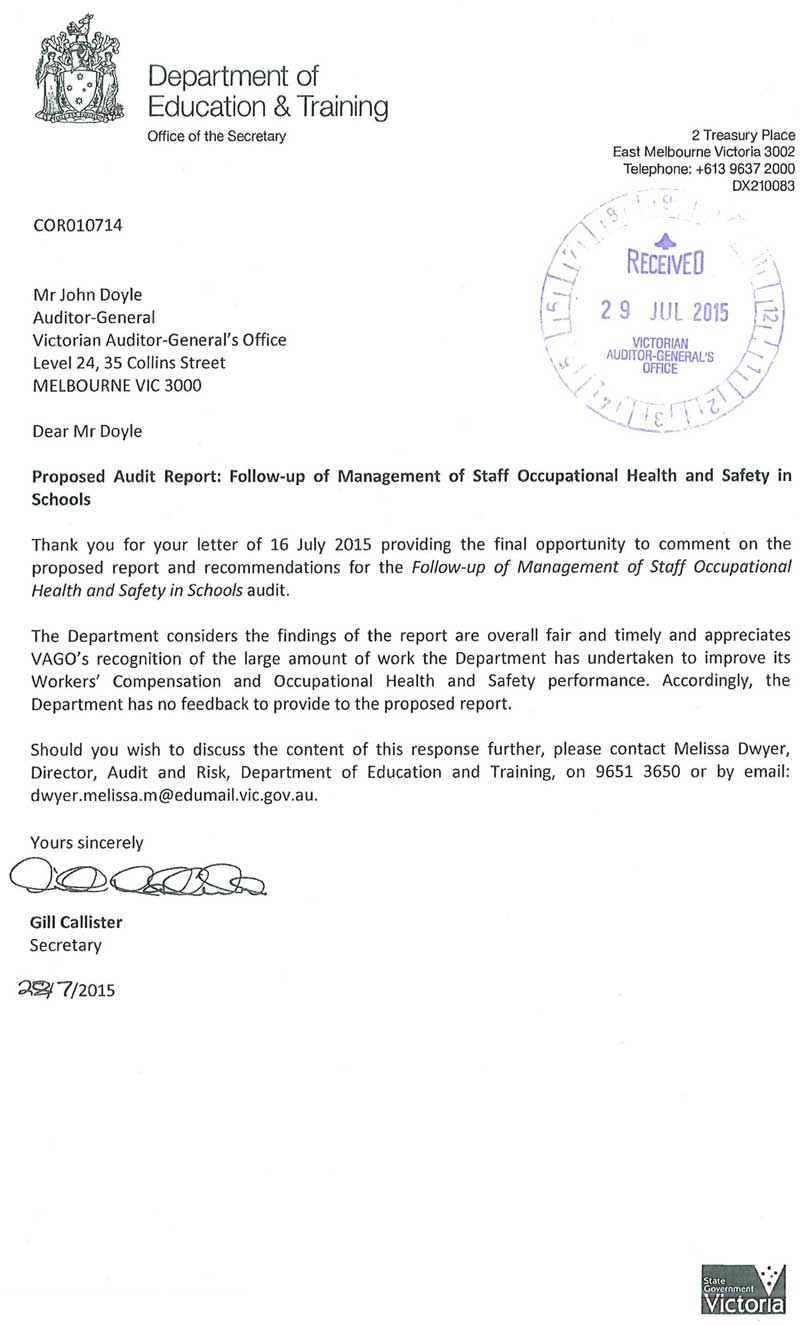
RESPONSE provided by the Chief Executive, WorkSafe Victoria

